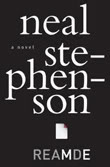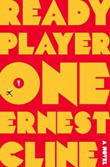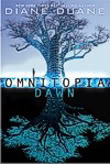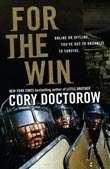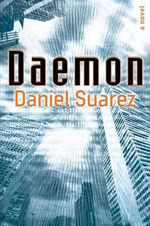Alex C. Telander's Blog, page 64
March 6, 2013
Bookbanter Column: In an MMO Far, Far Away (December 16, 2011)
There are many people on this planet who know what an MMO and/or an MMORPG is, but by the same token – like so many things in life – there are also many people who don’t what those acronyms mean. MMO stands for Massive Multiplayer Online, and MMORPG stands for Massive Multiplayer Online Role-Playing Game. Some examples of these MMOs include EverQuest, World of Warcraft, Lord of the Rings Online, and the forthcoming and constantly-growing-in-popularity Star Wars: The Old Republic, which is still in beta and scheduled to be fully released December 20. They’re essentially online video games that allow for much more ability and opportunity than usual console-based video games, and have no real end point: with each new expansion, players have higher levels to achieve, more quests to do, and more of the world to explore. Players get all this and more for a monthly fee, or some MMOs are free to play (ftp), but payment is required for certain quests or items. There are literally millions of MMO players across the planet, and I’m proudly one of them.
What’s interesting is that MMOs are starting to show up in fiction, mainly science fiction, usually as a construct of the fictional world the author has created. Sometimes it is a quasi dystopian future where playing the game is all there really is, while other books have the MMO be a main part of the story and play off it in the real world. It is an interesting growing sub-genre of science fiction that seems to get new additions each year.
Below are the books featuring MMOs that I have come across in my reading and reviewing, though I am sure there are more out there and invite anyone reading this column to elucidate on them in the comments section. As you read about these books and their respective MMOs, what do you think it says about our world and our society? More importantly, what do you think it says about where we’re headed? How likely is it that some form of one of these MMOs will come to be our reality? You be the judge.
Reamde by Neal Stephenson: Richard Forthrast is our approaching-middle-age hero who is one of the big brains behind the multi-billion dollar MMO, T’Rain, which is known throughout the world, whether you’re a rich white kid who likes to pretend he’s an elf, or a gold farmer somewhere in Asia looking to make some good money. T’Rain was in fact created with that in mind – Richard’s past is not a completely clean one by any means – to be open and available and possibly profitable to just about anyone on the planet with a good Internet connection. And then a very specific virus attacks T’Rain, known as Reamde, which immediately begins making a lot of money for its creators and screwing over a lot of the regular players. Richard and his team of brainiacs are now working round the clock trying to bring a stop to this.
Meanwhile, one of Richard’s family members – Zula – originally from East Africa and adopted into the family as a young girl, was hired by Richard to work for T’Rain, and becomes involved in a really big problem when her boyfriend Peter – who happens to be a renowned hacker – is looking to make good money selling credit card numbers to a shady, unknown character. Things take a turn for the worse, when the Reamde virus hits and screws everything up for him. Before they know it, the Russian mafia is breaking down their door, kidnapping them, and taking them to Asia by private jet to find the perpetrators of the Reamde virus and get their revenge. (Read the full review.)
Ready Player One by Ernest Cline: In the not-too-distant future, the world is quickly going to hell in a hand basket. It’s very much a dystopian world, but within this gloomy, depressing place is an MMO that just about everyone plays. OASIS is not just a game, but a way a life for most, where you can have fun, meet friends, got to school, and pretty much lead a full and entertaining life under the guise of your anonymous avatar (whose façade is of your choosing). Depending on what people can afford, the experience can be fully sensory so that players feel as if they are actually existing in the world of OASIS and experiencing it in just about every way possible.
James Halliday, who grew up in the 1980’s when computers were beginning to take off, quickly became addicted to video games and then began making his own. He is the creator of OASIS, which has gone from a game to life and reality for so many people in this world, and he is many times a billionaire. When he dies, he activates his will which states that whoever finds the three keys and solves the puzzles will be entitled to his entire fortune. Wade Watts is an eighteen year old nerd who has hopes of finding all three keys and gaining those untold riches. His parents are dead and he lives with an aunt who treats him terribly and he cares little for her, scraping by in abject poverty. And now he thinks he might’ve just found the location of the first key. (Read the full review; read an interview with the author.)
Omnitopia Dawn by Diane Duane: There are two worlds here: the compelling fantasy world of the massive multiplayer online game (MMO) Omnitopia and the real world where video game companies fight to keep doing what they do best and keep the fans hooked, and make lots of money. It is the near future and when one sits down to play an MMO – like Lord of the Rings Online or World of Warcraft – they can use the familiar screen and keyboard set up, or there is the full immersion into the game, akin to virtual reality only better, where one experiences almost all senses of the game. It is an incredible complex world of fighting and raiding, of gaining levels and increasing your wealth, and even eating and drinking with friends, while discussing your next strategies. But Omnitopia is unique as every once in a while it selects one of its subscribers to create their own unique world of their own choosing and actually make money from it. So there is the world of Omnitopia, and then there are the thousands of other user-created worlds covering all of history and the imagination. The result is a game that one can quite literally be completely absorbed by, almost forgetting the real world.
Rik Maliani is an ordinary person with an ordinary job who’s been a fan and player of Omnitopia for years. Then he gets selected to create his own world; it’s a dream come true, especially with the possibility of making serious money, but the question is what type of world to make? What would make it truly unique and encourage people to come see and play? As Rik begins creating his world, he notices some unusual events happening in the world of Omnitopia that seem to affect the one he is creating, but at the same time to be affected by his world somehow.
Dev Logan is the CEO of Omnitopia and started the whole enterprise many years ago as a college student, and is now the eighth richest man in the world because of it. He has a crack team of computer whizzes and geniuses who spend their days monitoring Omnitopia, making sure it’s running as smoothly as possible, and preventing the constant attacks and hacks against the worldwide popular MMO. And now things are really heating up, as the new expansion is about to be released. Everyone is working pretty much nonstop and none more so than Dev, who forgets to even eat at times. Delia Harrington is doing a story on Omnitopia for Time Magazine about the company and the expansion. As Dev deals with the reporter – who seems to be snooping around a little more than she should be – he’s constantly being barraged by updates and news on what’s happening with Omnitopia. It seems there are an absurd number of attacks building against the MMO, more so than usual, even for an expansion, but then that’s all in a day’s work for the CEO of Omnitopia.
Finally, there is Phil Sorensen, who was a good friend of Dev’s in college – they were going to revolutionize the gaming world together, but then had a falling out – and is the CEO for Infinity Inc. with his own giant, money-making MMO. He would like nothing more than to see everything that is Omnitopia come crashing down, and have Dev come crying back to him. He’s going to stop at nothing to make this happen. (Read the full review.)
For the Win by Cory Doctorow: For anyone who’s ever played an MMO game like World of Warcraft or Lord of the Rings Online, you know it can be a lot of fun. What you might not know is that if you’re really good at it, play it just right, and know where to advertise, you can make a lot of money from it. There are certain quests or missions that can be repeated over and over for maximum experience points and/or gold; that gold can be turned into cash. People who do this are known as gold farmers; it’s illegal; thousands of people around the world do it for profit. (Read the full review; listen to an interview with the author.)
Daemon by Daniel Suarez: Daemon begins with Matthew Sobol, a renowned computer programmer and video game designer, dead from cancer. It is upon his death, when the obituary is posted online, that the dormant daemon is unleashed upon the world. In this world – just like our own – everything is automated and computerized: banking, transportation, defense, government, patient records; there are few things remaining “off the grid.” The daemon works fast and incredibly efficient, beginning a systematic takedown of technology and world systems, causing deaths and the collapse of companies, and a financial meltdown that is scarily similar to the current economic climate.
It’s up to Detective Sebeck and computer genius Jon Ross to try and stop the daemon somehow from destroying everything. Then there is The Grid, the Massively Multiplayer Online Role-Playing Game – in the style of World of Warcraft and Lord of the Rings Online – created by Sobol, where the daemon secretly begins recruiting the disaffected but brilliant youth who play the game as part of its efforts to bring down technology and society. (Read the full
review; listen to an interview with the author.)
As you can see, each MMO is quite different in each book, and in how the MMO is used as a construct. Sometimes it is a tool for good, sometimes a tool for evil, and sometimes a tool for something completely different. Regardless of what the future may hold for us in the growing world of MMOs, and whether any of these possible and seemingly plausible realities will come into being, the fact that this subject is being written about by a growing number of different authors sends a message that this is not something we can just ignore or assume will go away. MMOs are here to stay, whether some of us like it or not, for good or ill; the question remains: how are they going to stay and what affect will they grow to and continue to have on our lives. Only the future knows.


March 5, 2013
Bookbanter Column: “November is National Novel Writing Month” (October 24, 2011)
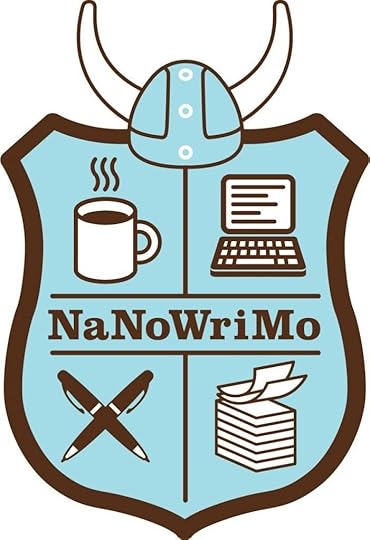
NaNoWriMo. Say it with me now: Nano-wri-mo; you can say it either “nano-ree-mo” or “nano-rye-mo.” And what exactly does this mean, you might ask? Well, it’s National Novel Writing Month, which takes place every November. The goal is a simple one: to write at least 50,000 words of a novel between November 1st and November 30th. While 50,000 words isn’t necessarily that long of a book, it is still a grand accomplishment once you put down that 50,000th word. Some popular novels that are this length include The Hitchhiker’s Guide to the Galaxy, Brave New World, and The Great Gatsby.
NaNoWriMo isn’t something special for long-term writers, or those who are looking to just get published, or even bestselling authors; the beauty about it is anyone can do it. You may be a writer looking to put down this great novel idea, or someone who has always just wanted to write a book; or you may be the type of person who has trouble finishing ideas and hitting goals. Whichever one or combination of these you might be, NaNoWriMo is the perfect place for you.
Begun in July of 1999 by Chris Baty, there were only twenty-one participants originally; it was moved to November to fit in better with the “miserable weather”; just eleven years later, in 2010, there were 200,000 participants. I myself have done it twice, back in 2002 for a young adult fantasy story that I’d wanted to turn into a book, and in 2004 with a story idea that turned into a thriller manuscript which I am currently shopping around to agents. A sister event has also developed for scriptwriting, which takes place in April called ScriptFrenzy. In 2005, NaNoWriMo started the Young Writers Program, which Chris Baty describes as:
“. . . A version of NaNoWriMo for kids, teens, and K-12 educators. On the Young Writers Program site kids from around the world can swap advice and encouragement with each other, get pep talks from Young Adult authors, and share their works-in-progress. We also have free downloadable workbooks for elementary, middle, and high-school students designed to help kids and teens plan their novels and learn about story structure.
Through the site, teachers also have access to six weeks’ worth of free lesson plans based on the NaNoWriMo challenge that map our curriculum to national standards for language arts education. And we mail all participating classrooms free stickers, posters, and buttons as well. This year, NaNoWriMo’s Young Writers Program will be taught in over 2,000 classrooms.
We also have a Young Writers Program dedicated to NaNoWriMo’s sister event, Script Frenzy. The offerings are very similar, and can be found at http://ywp.scriptfrenzy.org.”
Ultimately, participants can only get as much out of NaNoWriMo as they put in. Users can create a free account, but it’s up to them to update their progress with their novel on the website. With the free account, users are able to:
Plan your novel.
Join a local group of writers and attend in person writing events.
Receive online encouragement from staff and published authors.
Access a worldwide community of writers in our online forums
Theoretically, a user could just update their progress with the same word repeated over and over, but they would just be lying to themselves. NaNoWriMo is really about those who wish to achieve this important goal of writing a 50,000-word book.
Award-winning author Robert J. Sawyer, of Flashforward and most recently Wonder, has always been a big supporter of NaNoWriMo, has this to say:
“People always tell me they’d love to have my job — being a full-time professional writer. Well, NaNoWriMo affords a chance for them to get a taste of what it’s really like. Many professional novelists do 2,000 words of a draft every working day, and so that 50,000-words-in-a-month goal that those doing NaNoWriMo set for themselves is a taste of what it’s really like to be a career novelist, month in, month out, for decades. Actually doing that — cranking out 50,000 words to a tight deadline — is better than any writing course you could ever take or any workshop you could ever attend, because it’ll definitively answers the question of whether you’ve got what it takes, of whether you’re willing to sacrifice social and family events, other interests, and more, to produce the extraordinarily complex and wonderful thing that is a novel. On your marks, get set, go!”
The NaNoWriMo website also features encouraging blog posts from writing experts and popular authors, to get the fires going for NaNoWriMo participants. Recently, agent Rachelle Gardner even made a blog post about NaNoWriMo, though wisely including an important caveat:
“Standard agent disclaimer: DON’T YOU DARE send out that manuscript to agents on December 1. You and I know that a first draft written in 30 days is not ready for prime time. NaNoWriMo is for the purpose of writing a first draft. Take your time and make it good before submitting.”
The world of writing and publishing has changed a lot since the start of NaNoWriMo way back in 1999, with the advent of the eBook revolution and the growing world of self-publishing. When asked how NaNoWriMo has changed along with it, Chris Baty had this to say:
“The core concept of NaNoWriMo has always been that novel writing is a fun adventure, and that everyone who loves reading books should be writing them. I think NaNoWriMo has helped a lot of people get the first draft of a book written that they never would have otherwise. A lot of those writers go on to revise those manuscripts for years, even though they have no interest in getting an agent or going the traditional publishing route. They’re really just finishing the book because there’s a huge sense of satisfaction in doing so. The neat thing about the growth of print-on-demand and e-book publishing is that these books can find readers as soon as they’re done. I like that.
As for writers getting the most out of the program…I’d say the best thing to do is to fully commit to the 50,000-word goal and then arrange your November life in such a way that you have time to reach it. We get so busy taking care of other people’s needs that we rarely give ourselves time to tackle these crazy, invigorating challenges that make life so magical. For all the hard word you do the rest of the year, you deserve a month-long vacation in novel-land. Take it this November!
I’d also say it’s really important to turn off that critical voice that says you’re not good enough to write a novel. Novels really aren’t written by novelists. Novels are written by people who give themselves permission to write novels. You can do this. You should do this. Noveling is way too much fun to leave to the professionals.”
Now, the key I have found with NaNoWriMo, having taken the challenge a couple of times – and succeeded – is that it all comes down to that very important word count. This was my bread and butter when shooting for those 50,000 words. I made a chart with word count goals for every day in November, and then each day I would enter the number of words I did that day, and would then be able to keep track of how I was doing. If I started to lag behind, I could immediately tell by how many words and work extra hard to catch up. By the same token, if I got a decent “wordage” ahead, I could slack off a little; perhaps even take a day off of writing. The key to it all was knowing my word count, how I was doing, and how much I had to go.
And now you people, looking to tackle the great fun adventure that is NaNoWriMo this November are in for a treat, because at the end of this article you’ll find an Excel chart I made to help you in maintaining your word count throughout the month of August. To download it, simply right-click over the link and select “Save Link As.”
For now I wish you the best of luck in hitting your 50,000 words for NaNoWriMo . . . but then you and I both know it really doesn’t have much to do with luck. It’s all about hard work, buckling down, and cranking out those words. See you on the other side of November!
FREE NaNoWriMo Word Count Chart
(Click on the link to open the free file)


Bookbanter Column: “Thank You Borders” (September 16, 2011)
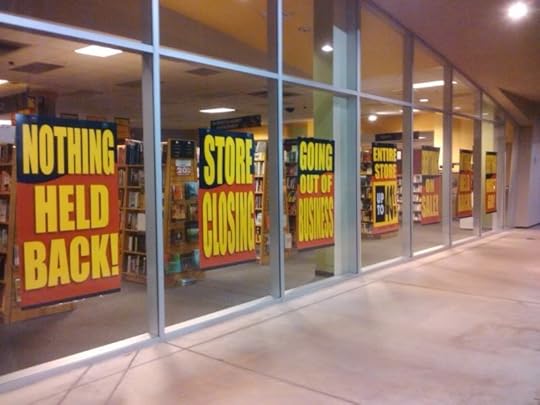 Window signs for Borders Roseville store #130 at the beginning of liquidation
Window signs for Borders Roseville store #130 at the beginning of liquidation
I started working for Borders in October of 2005; last October I had my fifth-year anniversary working for the company; by the beginning of October this year Borders Books, Music and More will no longer exist. It is estimated that around 10,700 people will lose their jobs when Borders closes its doors for good. The original Borders bookstore opened in 1971 in Ann Arbor, Michigan. At its height in 2003, Borders had 1,249 stores; five years later it announced its intention to sell. Two years of doubt and uncertainty followed, mainly for the Borders employees, knowing that the end would come and it was merely a case of when. A revolving door of CEOs and constant changes to upper management couldn’t stem or slow the tide of inevitability.
It is truly the end of an era, not just with all of us losing our jobs, but as a community venue that so many people have attended over the years. Whether it was for books, DVDs, music, coffee, Paperchase stationary items, or somewhere to enjoy a music performance or a signing on the weekend; Borders to many was a place to go and have fun. And now there will just be a series of big empty locales across the country.
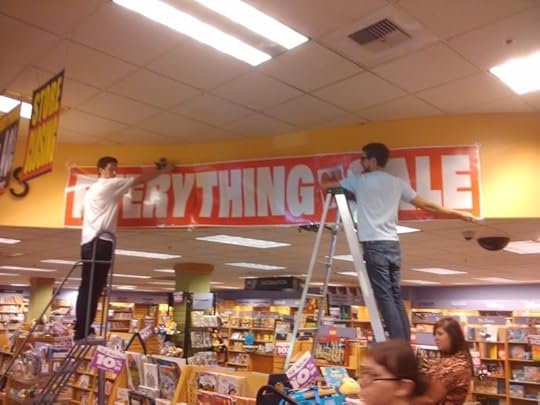
Employees putting up liquidation signs
Borders prided itself on carrying a wide variety of authors, especially during the better years when it wasn’t just bestsellers, but a large number of midlist authors that readers couldn’t find at Barnes and Noble, and wouldn’t be able to ever discover at Amazon.com. Independent bookstores do their best to carry many of these authors, but they don’t have the spread and range that Borders used to carry. In a recent interview with bestselling author George R. R. Martin, he indicated that a number of these authors will have a lot of trouble selling their books, what with the small publishers already owed millions by Borders, as well as not having such a large retailer to carry their titles anymore. The next few years are going to be interesting as readers, publishers, writers and booksellers look at what happens to this big hole in the book world. Will Amazon.com and Barnes & Noble automatically fill it? Will new independent bookstores begin to flourish across the country? Will eBooks fill this great void? Only the future will tell.
But Borders will not be quickly forgotten. Many of the employees in the history of Borders – as well as current ones – have had many fond memories of working for this institution. Many customers also have their own recollections of shopping at Borders, in fact at the beginning of the liquidation a customer came into the Folsom Borders asking if they could have a piece of the carpet once the store closed as it was there that she was proposed to; sadly she was not granted her wish as the carpet is needed for future tenants. Shortly after the liquidation announcement, Sourcebooks publisher Dominique Raccah created a special Twitter hashtag, #ThankUBorders, where everyone and anyone could share their fond memories and happy times with Borders; each and every day there are many new entries under this hashtag.
I could go on for paragraphs and paragraphs, reminiscing about my job and experiences at this place called Borders that I will never forget. I know on that last day, we’re going to need a lot of tissues. For now, I invite you to read what a variety of authors and one publisher have to stay about the end of Borders . . .

Letters and messages received from caring customers
“I am saddened by the demise of any book purveyor, though of course there must be a sadness hierarchy — with the defunct independents outranking the bankrupt chains. I long ago forgave Borders for shelving Stiff under Medical Reference, because they also chose the book for their Original Voices program, and that program was a nice a leg-up for a first-time author… “ – Mary Roach is the author of the bestselling Stiff, and most recently Packing for Mars.
“Borders was a wonderful chain, with terrific stores. It’s a huge loss to all of us. We mourn when a single bookstore closes, and rightly so — but when 700 close, it almost defies imagination. Countless communities will have no local bookstore at all. I’m truly sorry to see them go.” – Robert J. Sawyer is an award winning author; his most recent book is WWW: Wonder.
“Well, my thoughts aren’t particularly complicated. It’s a shame, even though we all sort of saw it coming. Fewer book stores – whether it’s a chain or an indie going bust – is bad for readers, and bad for writers. Fewer books available means fewer books sold. And for that matter, it means a number of (often) book-loving people are out of a job. Perhaps the Borders closings will open an opportunity for independent stores to rise up and fill the void – particularly in some of the markets where Borders was the only bookstore in the area. I’m not sure how viable or likely that is, but a girl can hope.” – Cherie Priest is the author of the bestselling Boneshaker.
“I can only talk about our local Borders, which was always wonderfully supportive of our books and events. I think the loss of any brick-and-mortar store is bad news. I do know that in later years I had several conversations with people in the book business who didn’t understand some of Borders’ business practices. Unnecessary expenditures, including over-production of author interview videos (when a lot of people are just using a hand-held flip camera, for example). I don’t know what I think really. ” – Jeff VanderMeer is the author of Booklife and Finch.
“I think it sucks. Leaving aside the fact that I still enjoy browsing real live bookshelves and this cuts down on my options for doing so, there’s the terrible economic impact this is going to have on the entire book industry. We were already facing an economic system dangerously denuded of “retailer ecodiversity” — and now the few remaining apex predators, no longer impeded by competition, are free to ravage anyone they see as lower on the food chain: namely, book producers and book lovers. It’s already happening, and now will get worse. Still, at least there’s one hope from the liquidation: Borders might finally be able to pay back the millions of dollars in unpaid-for books it’s owed to publishers and authors for years now.” – N. K. Jemisin is the author of The Hundred Thousand Kingdoms and The Broken Kingdoms.
“Any bookstore closing, chain or independent, is a cause for regret. We may enjoy our e-readers of all kinds, but there’s nothing quite like the feeling of walking into a bookstore and wondering what you’ll discover today, just by being among books, picking them up, sharing that space.” – Guy Gavriel Kay is the bestselling author of Tigana and Under Heaven.
“As both an author and a reader, the news of any bookstore closing is a tragedy. But when I learned about Borders closing I was particularly saddened. Borders was instrumental in making my first book, The Lost City of Z, a success. Borders employees were some of the most devoted readers, who recommended books and passed them on to customers. I did a reading at a Borders in Westchester, New York, near where I live, and was so struck by the extraordinary staff. And so when I think about those people who worked there losing their jobs, and all the readers and authors who will lose such a great place to gather and share their love of books, I’m left without words.” – David Grann is the writer for the New Yorker and the author of the bestselling Lost City of Z.
“First of all, my heart goes out to all the hardworking Borders salespeople and managers who have lost their jobs. The demise of Borders is a sad day for them, for us authors, for publishing houses, for the reading public — and indeed for our country. Fewer bookstores mean fewer books sold. It’s that simple. And that impoverishes us all.” – Douglas Preston is the bestselling co-author of Cemetery Dance and Gideon’s Sword.
“This is one chapter we hoped would never be written. But today’s business climate doesn’t take a sentimental approach. There are so many forces that conspired to effect Borders’ demise, but it boils down to the fact that the business model changed. Borders didn’t. I feel bad for all my friends and terrific booksellers who are losing their jobs, and the readers who lose their neighborhood bookstore. Borders was more than just a store…in its heyday, it was a community’s social pulse…a happening place where people gathered for book signings and musical concerts. It’ll be sorely missed.” – Alan Jacobson is the bestselling author of Crush and Inmate 1577.
“I’m crushed and shocked. The loss of Borders will have a resounding and lasting impact on the publishing market. Worst of all, it leaves fewer outlets for readers to easily browse, purchase, and explore new books. And the effect will reverberate throughout the economy as well: from the dumping of the 400 stores’ retail spaces into an already fragile marketplace to the 11,000 employees seeking new employment during these tough times. There is not a silver lining in any of this.”– James Rollins is the bestselling author of The Doomsday Key and The Devil Colony.
“Well, it’s funny, I remember when Borders was “cool.” —Before they became intent on opening a location next to every indie in town and running them out of business. I was so sorry to see their business model change; they really became the opposite of how they started. Borders was “sex-positive,” and gay-friendly in their infancy; back when it was considered risky. They were out front with graphic novels and comics. Whereas some prominent booksellers were saying: “No title with the word SEX in it will be allowed to have a signing in our store!”— Borders would welcome me. I think I first went to one in Chicago, that was fun. I also remember very well being in their Wall Street location a few months before 9/11. They had such a jolly time inviting me to “invade” the suits and have a reading there. I wish I could remember names better, because obviously, the good times were all about the great individuals I met, who in many cases, had been booksellers for years, at every kind of store. I hope I keep seeing them in the future!” – Susie Bright is the bestselling author of Big Sex Little Death, as well as the editor for The Best American Erotica.
“For any trade publisher the loss of Borders means that print runs will drop, in some cases by quite a lot for some categories in which Borders did well, which will then put pressure on unit costs and retail prices and profit margins. The knock-down effect would include loss of employees, fewer output, and more. And if this is the direction of chain stores, with indications that B&N will soon follow in five years, at least with attrition, as leases expire, then we could see a situation where publishers are either put out of business entirely or transitioned to ebook business models in order to save themselves. It’s a brave new world, but it’s anyone’s guess how brave and new it’s going to be.” – Sean Wallace is the editor and publisher for Prime Books.
“I think it’s a sad day when thousands of people lose their jobs and the ability of the consumer to browse through books in person becomes even more limited.” – Amber Benson is the author of Death’s Daughter and starred as Tara in Buffy the Vampire Slayer.
“The closing of Borders leaves an enormous void in the book world, not only physically but also spiritually. The professional implications to the publishing industry aside, there’s something about the experience of stepping into a book store that can’t be duplicated by browsing books on Amazon.com. If the other brick-and-mortar stores suffer the same fate as Borders, then we will have lost a fundamental piece of our culture.” – S.G. Browne is the author of Fated and Breathers.
“I’ll miss Borders. The closest bookstore to me right now is a Borders. It’s in a local shopping center that has a movie theatre, and nearly every time I go to the movies I go in there to shop. But that’s just the tiny little sliver of my personal regret. Thousands of people are losing their jobs. Big shopping centers will have massive empty real estate that will be hard to lease, and the cities and towns won’t be getting the taxes those businesses generate. Of course, even that is only one aspect of the loss taking place with Borders flaming out. Doubtless it will hasten the rush toward digital books as people have a harder time finding a bookstore. The long term picture–what publishing will look like a decade from now–is unclear. Perhaps once the conversion to digital is complete, or nearly so, that will create jobs and opportunities for writers. But in the short term, we’ll have to navigate carefully as the industry continues to undergo its metamorphosis.” – Christopher Golden is the author of numerous books including The Myth Hunters and The Map of Moments with Tim Lebbon.
“Borders was the only new book store near my house when I was a kid. I spent so many hours there. Borders was the bookstore that always had the book I wanted, that always had the people who knew what I was talking about. When I started publishing my own books, Borders was the bookstore that happily invited me in to sign and read and be a part of the bookstore dream. I miss my local stores so much. I can’t believe the whole chain is going away. It’s a loss to me as a writer, to me as a reader, and to me as a little girl who just wants to walk into a bookstore and be amazed.” – Seanan McGuire is the author of Late Eclipses and Feed under Mira Grant.


Bookbanter Column: “Too Much of a Good Thing” (July 20, 2011)
If there’s one thing that readers, writers and the publishing world have all learned from the likes of the Harry Potter and Twilight series, it is that children’s publishing seems to be going through a series of cycling genres right now. With the worldwide success of J. K. Rowling’s then relatively unique series, the children’s and young adult fantasy genre exploded with a glut of fantasy books — I should know, I was submitting my own YA fantasy manuscript to agents at the time and received nothing but rejections; this was in part due to the sheer number of YA fantasy manuscripts that agents and editors were receiving at that point, as well as possibly because my manuscript may not have been the work of pure, original genius I deemed it to be; but we won’t talk about that here – that still continues in the current time, partially because many of these YA fantasy books were the first in a series.
Then came Twilight and its overwhelming success, and then there was the glut of vampire books which has now slowed down. It has slowed down in part, because the next cycle of the children’s and YA genre has begun in the form of the dystopian story, which is because of the success of the Hunger Games series, which has spawned a large number of quickly written and published books on a doomed future involving teenagers. Just as with the stories about wizards and vampires, the ones about this hopeless future often straddle the line of a decent story and being outright asinine.
The same cycle phenomenon can certainly be applied to the adult science fiction and fantasy genre with the vampire, zombie, and post-apocalyptic stories, but because of just how bestselling Harry Potter and Twilight continue to be, with the current teen readers – as well as new teen readers discovering these respective series each year – publishers know there is a lot of money to be made from these books. It may not have the complexity and longevity of Harry Potter, or the sexual frisson and word-of-mouth support as Twilight, but if it’s a book with a cool cover that looks like it could be as good as Hunger Games, then kids and teens are going to buy it!
This is, of course, in part due to the fact that publishing is in a very uncertain and unpredictable place right now, with the advent of the ebook, and the future is not as concrete a s it has been in the past; but it’s also easier to just publish books that are popular, much like Hollywood has turned more to making movies of adapted screenplays instead of original ones.
Rachel Manija Brown, author of All the Fishes Come Home to Roost, has in fact done a series of posts on her blog that partly inspired this column.
“I got food poisoning and downloaded a bunch of first chapters of random recent YA science fiction to distract myself. To my amusement, most of them turned out to be dystopias – and many of them very similar dystopias. The idea that the government can control absolutely everything is meant to be horrifying in the books, but becomes hilarious when you read ten first chapters in a row in which the government controls your clothing, tattoos, water, emotions, marriage, writing, computers, jobs, college majors, families, games, and virginity.”
The original post can be found here. When asked why she thought so many YA dystopian books are being written, she responded:
“It’s a popular trend. Only time will tell whether it will have staying power or quickly fade away. While it’s always tempting to link trends to zeitgeists, it’s too easy to take any trend at all and then explain it away by linking it to something happening in the world. (“Big hair was popular in the eighties because it symbolized the empty grandiosity of America’s posturing on the world stage.”) My best guess is that YA dystopias are popular now because people really liked The Hunger Games and wanted to read more books like that. That, or both YA novelists and teenagers are afraid of nanny government.”
What I think is being crucially missed here with these dystopian stories is a message and resonance. When you think of some of the dystopian classics like 1984, The Jungle, Brave New World, and The Handmaid’s Tale to name a few, there was a strong message in each of these books, of a particular world that had gone down a wrong path, a path the real world should never make the mistake of going down. They were all possible worlds that could perhaps be, but we knew we could never let it go that far. The dystopian stories mentioned below are missing this important message; they are just there as a quick, simple story that leaves no lasting impression. Rachel weighs in on this:
“If the main thing I get from a book is the idea that teenage girls having sex is bad or that having the government control everything down to the color of your socks is bad or environmental destruction is bad – all messages contained in a number of YA dystopias I’ve read recently – then the book is too message-driven for my taste.”
In fifty or a hundred years, readers will still know of 1984 and The Handmaid’s Tale, but I’m pretty sure any of the books I’m about to mention likely won’t be remembered.
But enough chitchat, lets get to the books . . .
[image error]
Hunger Games: We begin first with the trilogy that really started the runaway train ride of the dystopian story. The Hunger Games are an event held each year in the Capitol of a changed America in a distant future, where two teens between the ages of twelve and eighteen are chosen from each district to participate in a unique arena where they must fight and battle each other to the death. The last remaining boy or girl alive wins and gets to spend the rest of their lives in splendor. The Hunger Games are meant to be a reminder to all the citizens of the districts of how bad times used to be, and how everyone should be happy and grateful to the Capitol and the ruling government.
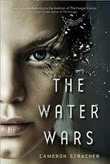
Water Wars by Cameron Stracher: In this future, American is a different place, with a whole new map of six republics that are at war with each other after what was known as the “Great Panic.” Here water has become scarce, as the great lakes and rivers have dried up. Republics now fight for rare wells and water sources for survival. Water consumption is controlled by a government body and it’s all about the haves and the have nots. This is also the story about a girl and a special boy who has the ability to “divine” sources of water.
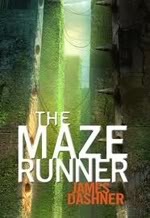
Maze Runner by James Dashner: The first in a trilogy, this is perhaps the most derivative of The Hunger Games, featuring an enclosed maze world where a boy finds himself mysteriously arriving by elevator. There he finds sixty other boys who have been trapped there for some time; a new boy arrives every thirty days. Then the first girl arrives.
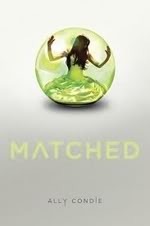
Matched by Ally Condie: The first in a trilogy, in this world nothing is left to chance and the Society Officials decide all aspects of daily life, so when the main character has her husband – who is her best friend – chosen for her, she believes the Society Officials know best, until she installs her Match microchip and sees a different boy.
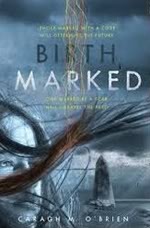
Birthmarked by Caragh M. O’Brien: The first in a trilogy, in this changed world women and girls have their sole roles of childrearing defined for them, with the main character playing the part of a midwife with her mother. The first three children must be offered to the government with the possibility of a better life in the city. Apparently it also involves inbreeding and “numerous birthing scenes.”
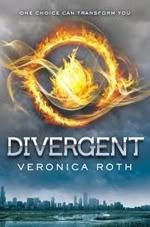
Divergent by Veronica Roth: The first in a trilogy, in this world a dystopian Chicago is divided into five factions dedicated to the development of a specific virtue – Candor (the honest), Abnegation (the selfless), Dauntless (the brave), Amity (the peaceful), and Erudite (the intelligent), and on a specific day each year all sixteen year olds must choose the faction they will devote the rest of their lives to.
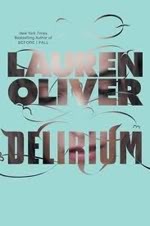
Delirium by Lauren Oliver: In this world of a controlling government, young Lena Haloway is looking forward to her eighteenth birthday, when she will finally be cured of “deliria,” which in this world is any form of love. Her mother committed suicide and her last words were “I love you.” That is until she meets a young man who changes her mind . . .
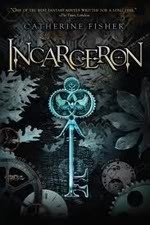
Incarceron by Catherine Fisher: The first in a series and originally published in Great Britain, Incarceron is a prison where people are born and die and know of little else, and Finn wants to escape, but legend says there has only ever been one person who has. Joining up with the warden’s daughter who also wants to escape, they discover a crystal key and a unique means of communicating with each other.

Wither by Lauren DeStefano: The first in a trilogy where scientists have tried to create perfectly genetically engineered children, and the first generation is nearly immortal, while successive generations begin to die early in age: girls at age 20, boys at age 25, and girls are now kidnapped and taken for brothels and marriages to breed children.
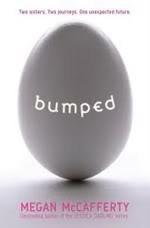
Bumped by Megan McCafferty: A virus has made everyone over the age of eighteen infertile and unable to conceive, turning young teens into baby-making machines for a certain fee, making them the most important members of society. Apparently, Bumped is written with a tongue-in-cheek attitude and humor, indicating that the author is at least aware of what she’s creating.
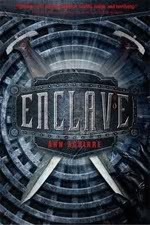
Enclave by Ann Aguirre: In this doomed world, children don’t earn the right to be named until the age of fifteen, since most of them apparently don’t survive that long. They are trained in one of three focuses: breeders, builders, or hunters, which is identified by how many scars they bear.

XVI by Julia Karr: Colloquially referred to as “Sexteen,” this book perhaps represents the worst of the worst as far as storyline goes. The year is 2150 and girls, when they turn the important age of sixteen, are branded with a tattoo that is supposed to protect them, but in fact notifies everyone around that they are now “sexually available.” It seems to be the book that puts women at the very lowest level of society.
This list by no means is comprehensive of the YA dystopian genre. I invite readers to comment of other bizarre and extreme books that they have discovered in this genre; or perhaps they saw something deeper and more meaningful in one of the books they read listed above.


March 4, 2013
Bookbanter Column: Where’s the Digital Copy for Books?
It seems these days we’re living in an impressively modern age where one can purchase a regular DVD or Blu-ray version of a movie, or a special edition which comes with a Blu-ray copy and a regular DVD version of the movie on a separate disc, allowing viewers to enjoy the movie on various devices of their choosing.
Take for example the recent release of the movie Moonrise Kingdom. The special Blu-ray edition includes a copy of the movie in Blu-ray, a copy on regular DVD, a digital copy that can be downloaded with a code, and even an Ultraviolet copy allowing you to be able to access the movie in the cloud to stream and download onto tablets, smartphones, computers and TVs.
The reason for this change in production is a logical one. This way people wanting to enjoy the movie, can do so on a variety of different devices — Blu-ray player, regular DVD player, tablet or even smartphone — at the same time with multiple members of a family or group of friends. It changes a product into something that can be freely enjoyed through a choice of devices at any time in about any given situation. I think this is a great advancement in movie production.
My question is: where is the equivalent for the book world?
I believe there is a logical and simple solution to this that will propel book production into the modern world alongside that of DVD production, and perhaps change the whole controversial subject of ebooks vs. print books.


March 2, 2013
Bookbanter Column: “Doing What’s Right” (May 21, 2011)
If knowledge is power, we live in an age where that power travels at the speed of light, or in the case of the Internet, the speed of a T1 line and a fiber optic cable. The information superhighway has become sort of a misnomer when applied to the worldwide web, as the information conveyed now travels so much faster than an automobile traveling at eighty, ninety or a hundred miles an hour, along with the likes of Facebook, Twitter, and the many thousands of blogs out there updating every minute and hour of every day. So when a bad decision is made by an editor and then a publisher, not all the apologies and changes of heart in the world can affect the outcome once the author has made her decision, pulled her story, and blogged about it on the Internet.
Let me backtrack a little first.
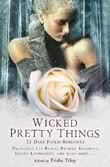
The young adult anthology Wicked Pretty Things was originally scheduled to come out in September of this year featuring a number of popular as well as up and coming authors including Jessica Verday; edited by Trisha Telep and published by Running Press in the US and Constable & Robinson in the UK. Telep had pitched it as “a collection of dark fairy YA stories (with a bit of a romantic edge).” Verday submitted a story, “Flesh Which is Not Flesh,” for the collection that featured a relationship between Wesley and Cameron, two boys. She was then told by Telep that the story would be published so long as she made one of her characters female as a “male/male story would not be acceptable to the publishers.” Verday thought about this for a while and then made the important decision that she knew she had to: she withdrew her story from the anthology, making her stance clear in a post on her blog. This was a hard choice for Verday, who has only published three books in a trilogy and is still an up and coming author, but she chose to stay true to what she believed and what she thought was the righting thing to do.
In a follow up post, Verday defended her decision and presented the comments and responses from the publisher, which was essentially that while the publisher regretted the decisions and actions of the editor, they were still going forward with the anthology, along with keeping Telep as the editor. It was acknowledged all around that bad choices had been made on the part of Telep and that they would now willingly publish “Flesh Which is Not Flesh” in its original form. But Verday wasn’t changing her mind, as the initial “knee-jerk” bad decision had still been made and to now pretend like it hadn’t happened would completely defeat the point of Verday making this decision in the first place. Also the publisher had said that it was a case of miscommunication with the editor and that they had never been consulted in the matter, and publisher Christopher Navratil even wrote an article entitled What Happens When a Headline Goes Viral for Publishers Weekly about it; the issue here was that the publisher kept saying they did not support Telep on this decision by any means, and yet they were still standing behind her and publishing the anthology. Running Press were essentially covering their bases however they could to save face and look good and put the whole matter to bed. Telep was very apologetic, saying “I sincerely regret the sequence of events which has led to Jessica Verday’s story ‘Flesh Which Is Not Flesh’ being excluded from the forthcoming anthology Wicked Pretty Things. This has been the result of a misunderstanding on my part which is entirely regrettable … I fully support LGBTQ issues.” Yet as Jim C. Hines clearly put it on his blog: “But it was hurtful.”
Much to Telep’s and the publisher’s chagrin, the matter wasn’t going to die. Verday had spoken her mind on her blog and word spread across the Internet as more blogs and Twitter accounts and readers heard and learned about the story and then broadcasted it on their respective networking communication site of choice (including the BookBanter Blog). Then Lisa Mantchev, Lesley Livinston, Karen Mahoney and Seanan McGuire – all authors that were to be featured in the anthology – withdrew their stories for publication, and Melissa Marr asked that her name not be used to promote the project. McGuire, much like Verday, is a relatively new author who has gone on to win the John W. Campbell Award in 2010 for Best New Writer and be listed on the New York Times bestseller list. In a heartfelt post McGuire makes her viewpoint clear: “I am not withdrawing from this book because I’m not straight. I am withdrawing because of my little sister and her wife, and because of my girlfriend, and because of my best friend, and because of all the other people who deserve better than bullying through exclusion.” Each of these authors had to make hard decisions that may certainly have affected their careers, and yet they stood behind their choices and never backed down.
But there was still more. Fantasy author Jim C. Hines made a post on his popular blog with the title of “Wicked Pretty Things and the Erasure of LGBTQ Characters.” In the post he begins it with a conversation between his six-year old child and himself in clarifying that marriages do not have to be solely between girls and boys, whereupon his son responds with: “That’s silly. How would they have babies?” Hines commented with: “I understand where his confusion comes from. Pretty much every cartoon on TV has male/female relationships only. Every movie he watches, every book he brings home from school… Any nonheterosexual relationship is simply erased.” Then he segues to Jessica Verday and lays out what happened, citing his sources everywhere he can and makes his point on that matter clear. Then he goes one giant step further in offering to publish the authors’ stories that were withdrawn from the anthology, as well as pay them under the following conditions:
If you have not already found a home for your withdrawn story, I would be happy to read it.
If I like the story (and knowing most of the authors involved, I suspect I will), I’ll offer $100 up front to publish it here on my blog.
Each story will include a donations link. Once the initial $100 has been covered, further donations will be split 50/50. Half will be paid to the author, and the other half will be donated to a LGBTQ-friendly cause.
If I publish multiple stories, I will look into putting together an e-book collection of those stories, with profits again being split between the authors and a LGBTQ-friendly cause.
The post went on to receive a large number of comments and when asked recently how Hines’s decision had continued to be received, he responded with:
“I made my offer because I agreed with the authors. An editor has every right to decide what she will and won’t publish, but if you’re an editor who refuses to publish LGBT content or assumes such content is automatically ‘inappropriate,’ I have the right to refuse to work with you. A lot of people were writing to express their support for these authors, and I figured the best way I could show my own support was to offer to buy and publish those withdrawn stories.
I’ve spoken to several ex-WPT [Wicked Pretty Things] authors so far. Some of them have already found other homes for their work, which is great. I’m waiting to hear from a few others. I just want to make sure these authors are able to be paid for their stories, and that — hopefully — we’ll all be able to read and enjoy them.”
In my last round of researching for this column as I began to write it, I came across the announcement – albeit not officially emblazoned on their site or displayed anywhere – that the publisher had canceled the publication of Wicked Pretty Things. It looks like enough people were making a big enough deal about this to force the publisher to make their own hard decision on the many choices that authors, writers and bloggers alike had already made. This was the right outcome.
The bottom line is this: Trisha Telep made the wrong call in asking Verday to change her story because she thought it wouldn’t be accepted by the publisher for the anthology, even though it followed the guidelines laid out by the publisher. But once that call had been made, the stance and point were clear and feelings had been very much hurt, and not all the apologies and regrets from Telep or the publisher could change the fact that when Telep saw it was a gay story (“a total of 3 kisses and sexually, it’s G-rated”) about two teenage boys, she said no.
And to end this column on a lighter note, while Running Press will no longer be publishing Wicked Pretty Things this year, it is nevertheless the proud publisher of the book Threesomes and Moresomes, which Nick Mamatas has kindly shown the cover for on his blog. Nothing wrong with that book, right?
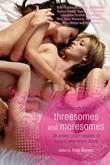

Bookbanter Column: “Doing What’s Right” (May, 2011)
If knowledge is power, we live in an age where that power travels at the speed of light, or in the case of the Internet, the speed of a T1 line and a fiber optic cable. The information superhighway has become sort of a misnomer when applied to the worldwide web, as the information conveyed now travels so much faster than an automobile traveling at eighty, ninety or a hundred miles an hour, along with the likes of Facebook, Twitter, and the many thousands of blogs out there updating every minute and hour of every day. So when a bad decision is made by an editor and then a publisher, not all the apologies and changes of heart in the world can affect the outcome once the author has made her decision, pulled her story, and blogged about it on the Internet.
Let me backtrack a little first.

The young adult anthology Wicked Pretty Things was originally scheduled to come out in September of this year featuring a number of popular as well as up and coming authors including Jessica Verday; edited by Trisha Telep and published by Running Press in the US and Constable & Robinson in the UK. Telep had pitched it as “a collection of dark fairy YA stories (with a bit of a romantic edge).” Verday submitted a story, “Flesh Which is Not Flesh,” for the collection that featured a relationship between Wesley and Cameron, two boys. She was then told by Telep that the story would be published so long as she made one of her characters female as a “male/male story would not be acceptable to the publishers.” Verday thought about this for a while and then made the important decision that she knew she had to: she withdrew her story from the anthology, making her stance clear in a post on her blog. This was a hard choice for Verday, who has only published three books in a trilogy and is still an up and coming author, but she chose to stay true to what she believed and what she thought was the righting thing to do.
In a follow up post, Verday defended her decision and presented the comments and responses from the publisher, which was essentially that while the publisher regretted the decisions and actions of the editor, they were still going forward with the anthology, along with keeping Telep as the editor. It was acknowledged all around that bad choices had been made on the part of Telep and that they would now willingly publish “Flesh Which is Not Flesh” in its original form. But Verday wasn’t changing her mind, as the initial “knee-jerk” bad decision had still been made and to now pretend like it hadn’t happened would completely defeat the point of Verday making this decision in the first place. Also the publisher had said that it was a case of miscommunication with the editor and that they had never been consulted in the matter, and publisher Christopher Navratil even wrote an article entitled What Happens When a Headline Goes Viral for Publishers Weekly about it; the issue here was that the publisher kept saying they did not support Telep on this decision by any means, and yet they were still standing behind her and publishing the anthology. Running Press were essentially covering their bases however they could to save face and look good and put the whole matter to bed. Telep was very apologetic, saying “I sincerely regret the sequence of events which has led to Jessica Verday’s story ‘Flesh Which Is Not Flesh’ being excluded from the forthcoming anthology Wicked Pretty Things. This has been the result of a misunderstanding on my part which is entirely regrettable … I fully support LGBTQ issues.” Yet as Jim C. Hines clearly put it on his blog: “But it was hurtful.”
Much to Telep’s and the publisher’s chagrin, the matter wasn’t going to die. Verday had spoken her mind on her blog and word spread across the Internet as more blogs and Twitter accounts and readers heard and learned about the story and then broadcasted it on their respective networking communication site of choice (including the BookBanter Blog). Then Lisa Mantchev, Lesley Livinston, Karen Mahoney and Seanan McGuire – all authors that were to be featured in the anthology – withdrew their stories for publication, and Melissa Marr asked that her name not be used to promote the project. McGuire, much like Verday, is a relatively new author who has gone on to win the John W. Campbell Award in 2010 for Best New Writer and be listed on the New York Times bestseller list. In a heartfelt post McGuire makes her viewpoint clear: “I am not withdrawing from this book because I’m not straight. I am withdrawing because of my little sister and her wife, and because of my girlfriend, and because of my best friend, and because of all the other people who deserve better than bullying through exclusion.” Each of these authors had to make hard decisions that may certainly have affected their careers, and yet they stood behind their choices and never backed down.
But there was still more. Fantasy author Jim C. Hines made a post on his popular blog with the title of “Wicked Pretty Things and the Erasure of LGBTQ Characters.” In the post he begins it with a conversation between his six-year old child and himself in clarifying that marriages do not have to be solely between girls and boys, whereupon his son responds with: “That’s silly. How would they have babies?” Hines commented with: “I understand where his confusion comes from. Pretty much every cartoon on TV has male/female relationships only. Every movie he watches, every book he brings home from school… Any nonheterosexual relationship is simply erased.” Then he segues to Jessica Verday and lays out what happened, citing his sources everywhere he can and makes his point on that matter clear. Then he goes one giant step further in offering to publish the authors’ stories that were withdrawn from the anthology, as well as pay them under the following conditions:
If you have not already found a home for your withdrawn story, I would be happy to read it.
If I like the story (and knowing most of the authors involved, I suspect I will), I’ll offer $100 up front to publish it here on my blog.
Each story will include a donations link. Once the initial $100 has been covered, further donations will be split 50/50. Half will be paid to the author, and the other half will be donated to a LGBTQ-friendly cause.
If I publish multiple stories, I will look into putting together an e-book collection of those stories, with profits again being split between the authors and a LGBTQ-friendly cause.
The post went on to receive a large number of comments and when asked recently how Hines’s decision had continued to be received, he responded with:
“I made my offer because I agreed with the authors. An editor has every right to decide what she will and won’t publish, but if you’re an editor who refuses to publish LGBT content or assumes such content is automatically ‘inappropriate,’ I have the right to refuse to work with you. A lot of people were writing to express their support for these authors, and I figured the best way I could show my own support was to offer to buy and publish those withdrawn stories.
I’ve spoken to several ex-WPT [Wicked Pretty Things] authors so far. Some of them have already found other homes for their work, which is great. I’m waiting to hear from a few others. I just want to make sure these authors are able to be paid for their stories, and that — hopefully — we’ll all be able to read and enjoy them.”
In my last round of researching for this column as I began to write it, I came across the announcement – albeit not officially emblazoned on their site or displayed anywhere – that the publisher had canceled the publication of Wicked Pretty Things. It looks like enough people were making a big enough deal about this to force the publisher to make their own hard decision on the many choices that authors, writers and bloggers alike had already made. This was the right outcome.
The bottom line is this: Trisha Telep made the wrong call in asking Verday to change her story because she thought it wouldn’t be accepted by the publisher for the anthology, even though it followed the guidelines laid out by the publisher. But once that call had been made, the stance and point were clear and feelings had been very much hurt, and not all the apologies and regrets from Telep or the publisher could change the fact that when Telep saw it was a gay story (“a total of 3 kisses and sexually, it’s G-rated”) about two teenage boys, she said no.
And to end this column on a lighter note, while Running Press will no longer be publishing Wicked Pretty Things this year, it is nevertheless the proud publisher of the book Threesomes and Moresomes, which Nick Mamatas has kindly shown the cover for on his blog. Nothing wrong with that book, right?


Bookbanter Column: “Zombie is the New Undead” (April 11, 2011)
You sit in your favorite chair, in your favorite room of the house: the library. Your legs are comfort- ably crossed, the temperature is just right: warm and cozy. You’re reading your favorite book on your Ipad, swiping your finger rapidly across the screen to turn the page and continue with the gripping story. You’ve tuned out the world, focused on the captivating story with the unstoppable heroine who is fighting to save the day; you know she will triumph, but you still read for the inevitable surprise. As you begin a new chapter, you finally here a scratching at the door. But you have no pets; who could it be? The scratching continues, as if whatever is on the other side is trying to claw their way through the door. It is then that you hear the deep, inhuman groaning. You put down your Ipad, fear crawling its way up your spine, as you hesitantly walk towards the door. Building up your courage – kidding yourself that it’s just your little brother playing around, but you secretly know better – you fling open the door and scream as the zombie reaches out for you . . .
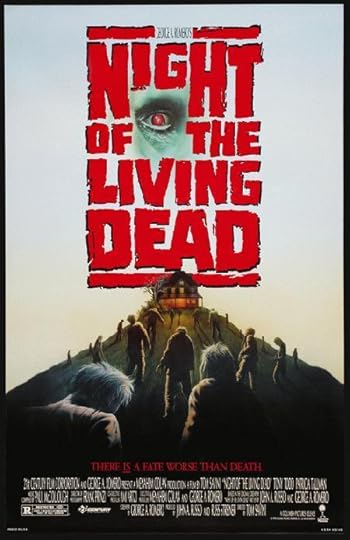
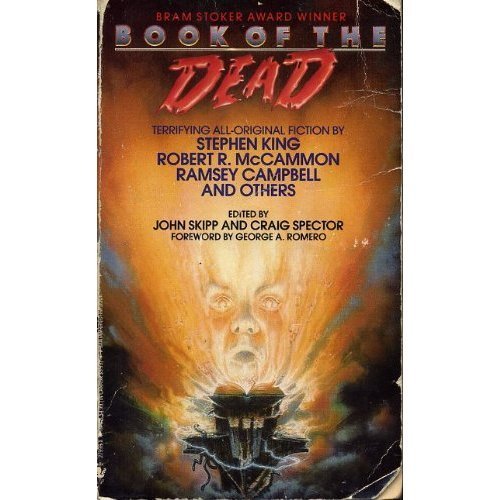
Zombie. Dictionary.com defines it as “the body of a dead person given the semblance of life, but mute and will-less, by a supernatural force, usually for some evil purpose.” Wikipedia says, “A fictional undead monster or a person in an entranced state believed to be controlled by a bokor or wizard.” But if I was to refer to Night of the Living Dead, you would have a concrete image in your mind of a weak, slow-moving undead human with its arms stretched out, groaning and moaning, hungrily in search of brains. While the concept of zombies has been around for a long time, George A Romero’s cult classic brought the idea of the walking dead human back to life in a whole new way, spawning countless successive zombie movies.
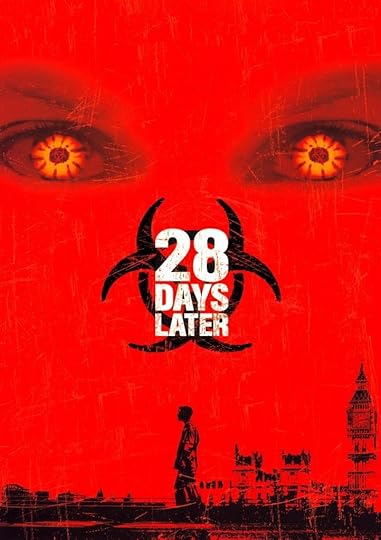
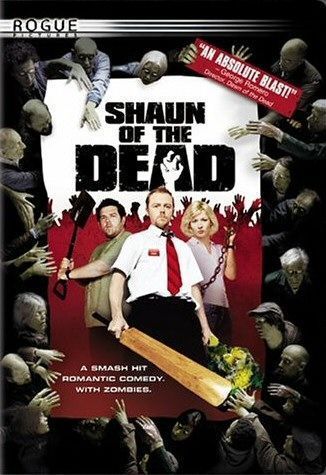
Zombies have appeared numerous times in literature, but it wasn’t until the publication of The Book of the Dead in 1989 that we first saw a collection of zombie stories, based on the premise from Night of the Living Dead. The image of the archetypal zombie described above had fully solidified in our society’s conscious. But during the first decade of the twenty-first century there was a drastic change in the familiar paradigm of the zombie, thanks to the likes of 28 Days Later (2002) and Shaun of the Dead (2004) in film, and Max Brooks’ Zombie Survival Guide published in 2003, followed by his New York Times bestseller World War Z (2006).
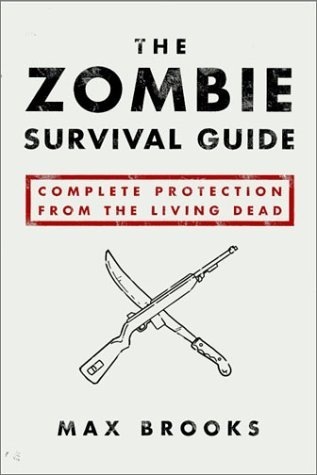
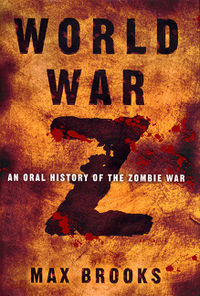
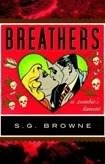
All of a sudden the zombie wasn’t a scary, slow-moving creature, but one that was an incredibly fast, terrifying nightmare, or could be funny and entertaining; a pet to be kept in your shed. It was a creature we fought a war with and barely survived. It was, jokingly, something we might one day have to face, and here were some detailed ways to protect yourself. S. G. Browne, author of the bestselling Breathers – a book about how zombies would be treated as members of society – has this to say about our contemporary zombies:
“In addition to running like Olympic sprinters and making us laugh, modern zombies are domesticated as pets (Fido), write poetry (Zombie Haiku), and have invaded classic literature (Pride and Prejudice and Zombies). They can also be found on the Internet going to marriage counseling, falling in love, and singing to their former co-workers (Jonathan Coulton’s “Re: Your Brains.”) In short, they’ve expanded their range, become more versatile. More well-rounded. And who doesn’t enjoy a more well-rounded zombie? Plus, zombies are tragically comical. Shuffling along, losing their hair and teeth and nails and the occasional appendage. Add the fact that they used to be us and we can’t help but relate to them.”
And what is it about these undead that fascinates us so? Browne’s last sentence does point out an interesting fact that zombies were once people, and when we recognize the person, that is when we have issues in “putting them to rest.” But what is resonating with humanity on a psychological level to want to read and watch and experience the thrill of a living corpse coming for you? Browne continues:
“The prevailing argument I often hear describes the current popularity of zombies as a direct reflection of global fears regarding the economy and terrorism. Horror as catharsis for the fears and anxiety of a society making commentary on itself. I disagree. I believe the current fascination with zombies has less to do with economic angst and more to do with the fact that zombies have been taken out of their proverbial archetypal box. No longer are they just the shambling, mindless, flesh-eating ghouls we’ve known and loved for most of the past four decades. Today’s zombies are faster. Funnier. Sentient.”
This is but one opinion on why we enjoy watching and reading about zombies. Mira Grant, author of the bestselling Feed – set in a techie near future where a virus can turn anyone into a zombie – presents another viewpoint:
“Zombies are, in many ways, a blank slate for our fears — they let us fear illness, fear sublimation, fear the terror of the familiar becoming the alien – without admitting that those fears cannot always be fought in a physical form. And in a time when so many of the classic monsters are being sexualized and humanized, zombies are one of the only things it’s still acceptable to hate and fear on sight.”
Grant brings up an important point. The world of vampires over the last two decades has certainly been revamped (pun intended!) with the likes of Louis (Brad Pitt) and Lestat (Tom Cruise) in the 1994 adaptation of Interview with a Vampire, Angel and Spike from Buffy the Vampire Slayer, and – of course – Edward (Robert Pattison) from The Twilight Saga. While there have been a number of stories and books about “likeable” zombie characters, no true hero has been raised from the grave.
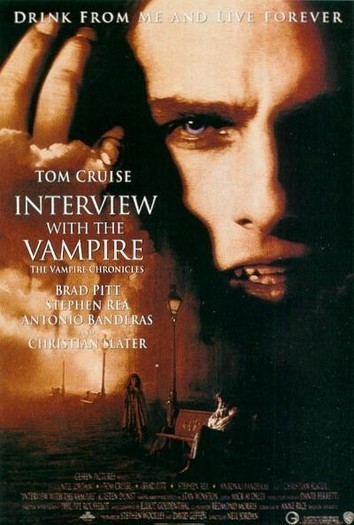
And yet zombies continue to pervade every sphere of entertainment, as well as every genre of writing, whether it’s bestselling anthologies like John Joseph Adams’ Living Dead, or Christopher Golden’s New Dead; to original novels like Brian Keene’s The Rising, Jonathan Maberry’s Joe Ledger series, or Stephen King’s Cell; to the popular graphic novel series (and now successful TV series) The Walking Dead; to international levels with Swedish author of Let the Right One In, John Ajvide Lindqvist’s Handling the Undead. To say I am barely scratching the tip of the iceberg does not do the list of zombie literature justice. Readers may want to check out the Wikipedia page on a “List of Zombie Novels” for further details.
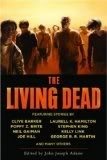
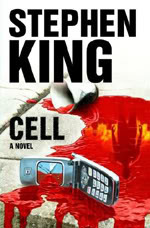
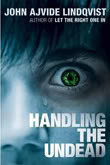
Jonathan Maberry has even brought the subject of zombies to the popular world of young adult fiction with his first book in the series, Rot & Ruin. Maberry came up with the idea when asked to do a story for the New Dead anthology: “I decided to explore the experience of a teenager dealing with something vastly beyond his control. During the writing of the novella I fell in love with the characters and the world of the Rot & Ruin (which is what everything is called that’s beyond the fence line of the small town in which the characters live).” With the success of the first book, Maberry has three sequels planned, with Dust & Decay coming out in August. Even he has been surprised with the success of the “young adult zombie” novel: “It’s won a number of awards already including the Cybils and Dead Letter Award, and has been nominated for a Stoker, the YASLA and others.”
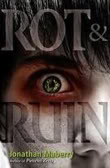
But will the zombie fascination ever come to an end? As a bookstore employee for the last seven years, I have seen the rise of zombie fiction, and while it does seem to have slowed a little, an end appears nowhere in sight. On this topic, Grant says,
“I don’t think the zombie fascination will die down or cool off until we stop being afraid of going to the doctor, of the man on the subway, of the woman with the pamphlet telling us to repent. They’re the monsters for this modern age. The vampire had a pretty good run as the biggest bad in existence — about five hundred years, give or take. I doubt the zombie will break that record, but it’s going to try.”
While John Joseph Adams, editor of the successful Living Dead anthologies, has this to say:
“I think it’s safe to say that zombies will continue to be popular for the foreseeable future. In literature, everything zombie-related has so much competition right now, however, it’s become really hard to stand out. But I think there’s a core fan-base for zombie fiction that will buy up every zombie book they get their hands on, so it’s a safe bet from a publishing point of view–i.e., put zombies in it, and it’ll sell. (The art director corollary is “Put an airship on it, and it’ll sell.) It’ll be interesting to see how things develop; if the zombie genre is going to continue to thrive, its practitioners will have to figure out ways to innovate while keeping things traditional enough so as not to alienate the existing and loyal core fan-base. Fortunately for the genre, zombies work well as a blank canvas and can be easily made to do the writer’s bidding.”
The Age of the Zombie is still alive, undead, and well, because the archetype of the zombie has been so drastically altered. Zombies are like superheroes now, in that there is little limitation to what they may be capable of. Writers are constantly coming up with new and different ways to present the living dead, whether it’s decaying family members we feel the need to aid in Handling the Undead, or the concept of a zombie prostitute in S. G. Browne’s short story “Zombie Gigolo” from Living Dead 2, or even zombie Stormtroopers in Joe Schreiber’s Star Wars: Death Troopers. Anthologies, on the other hand, help to reveal zombie stories known authors have written, but also pose a challenge of writing a zombie story by a writer not know for this genre. In fact, in five years time it is far more likely that the remaining bookstores will have an individual zombie section, separate from their horror section. It really boils down to a relatively simple concept, which Adams pointed out above: as long as there are people buying and reading zombie stories, publishers will continue to publish it, and writers will therefore continue to write it, as well as parody it. Think of it as a never ending cycle, if you will, or perhaps an undead cycle that cannot be put to rest.
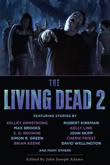
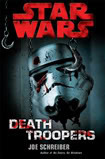
Author’s note: The zombie works mentioned above are just a smattering of the whole body of zombie work, covering all mediums. As a reader and movie watcher, I know I have only been exposed to a small amount. I invite readers to post comments on their favorite zombie stories, or perhaps rare ones that not many are familiar, as well as anything else they might want to mention about the living dead.


Bookbanter Column: “Zombie is the New Undead” (April, 2011)
You sit in your favorite chair, in your favorite room of the house: the library. Your legs are comfort- ably crossed, the temperature is just right: warm and cozy. You’re reading your favorite book on your Ipad, swiping your finger rapidly across the screen to turn the page and continue with the gripping story. You’ve tuned out the world, focused on the captivating story with the unstoppable heroine who is fighting to save the day; you know she will triumph, but you still read for the inevitable surprise. As you begin a new chapter, you finally here a scratching at the door. But you have no pets; who could it be? The scratching continues, as if whatever is on the other side is trying to claw their way through the door. It is then that you hear the deep, inhuman groaning. You put down your Ipad, fear crawling its way up your spine, as you hesitantly walk towards the door. Building up your courage – kidding yourself that it’s just your little brother playing around, but you secretly know better – you fling open the door and scream as the zombie reaches out for you . . .


Zombie. Dictionary.com defines it as “the body of a dead person given the semblance of life, but mute and will-less, by a supernatural force, usually for some evil purpose.” Wikipedia says, “A fictional undead monster or a person in an entranced state believed to be controlled by a bokor or wizard.” But if I was to refer to Night of the Living Dead, you would have a concrete image in your mind of a weak, slow-moving undead human with its arms stretched out, groaning and moaning, hungrily in search of brains. While the concept of zombies has been around for a long time, George A Romero’s cult classic brought the idea of the walking dead human back to life in a whole new way, spawning countless successive zombie movies.


Zombies have appeared numerous times in literature, but it wasn’t until the publication of The Book of the Dead in 1989 that we first saw a collection of zombie stories, based on the premise from Night of the Living Dead. The image of the archetypal zombie described above had fully solidified in our society’s conscious. But during the first decade of the twenty-first century there was a drastic change in the familiar paradigm of the zombie, thanks to the likes of 28 Days Later (2002) and Shaun of the Dead (2004) in film, and Max Brooks’ Zombie Survival Guide published in 2003, followed by his New York Times bestseller World War Z (2006).



All of a sudden the zombie wasn’t a scary, slow-moving creature, but one that was an incredibly fast, terrifying nightmare, or could be funny and entertaining; a pet to be kept in your shed. It was a creature we fought a war with and barely survived. It was, jokingly, something we might one day have to face, and here were some detailed ways to protect yourself. S. G. Browne, author of the bestselling Breathers – a book about how zombies would be treated as members of society – has this to say about our contemporary zombies:
“In addition to running like Olympic sprinters and making us laugh, modern zombies are domesticated as pets (Fido), write poetry (Zombie Haiku), and have invaded classic literature (Pride and Prejudice and Zombies). They can also be found on the Internet going to marriage counseling, falling in love, and singing to their former co-workers (Jonathan Coulton’s “Re: Your Brains.”) In short, they’ve expanded their range, become more versatile. More well-rounded. And who doesn’t enjoy a more well-rounded zombie? Plus, zombies are tragically comical. Shuffling along, losing their hair and teeth and nails and the occasional appendage. Add the fact that they used to be us and we can’t help but relate to them.”
And what is it about these undead that fascinates us so? Browne’s last sentence does point out an interesting fact that zombies were once people, and when we recognize the person, that is when we have issues in “putting them to rest.” But what is resonating with humanity on a psychological level to want to read and watch and experience the thrill of a living corpse coming for you? Browne continues:
“The prevailing argument I often hear describes the current popularity of zombies as a direct reflection of global fears regarding the economy and terrorism. Horror as catharsis for the fears and anxiety of a society making commentary on itself. I disagree. I believe the current fascination with zombies has less to do with economic angst and more to do with the fact that zombies have been taken out of their proverbial archetypal box. No longer are they just the shambling, mindless, flesh-eating ghouls we’ve known and loved for most of the past four decades. Today’s zombies are faster. Funnier. Sentient.”
This is but one opinion on why we enjoy watching and reading about zombies. Mira Grant, author of the bestselling Feed – set in a techie near future where a virus can turn anyone into a zombie – presents another viewpoint:
“Zombies are, in many ways, a blank slate for our fears — they let us fear illness, fear sublimation, fear the terror of the familiar becoming the alien – without admitting that those fears cannot always be fought in a physical form. And in a time when so many of the classic monsters are being sexualized and humanized, zombies are one of the only things it’s still acceptable to hate and fear on sight.”
Grant brings up an important point. The world of vampires over the last two decades has certainly been revamped (pun intended!) with the likes of Louis (Brad Pitt) and Lestat (Tom Cruise) in the 1994 adaptation of Interview with a Vampire, Angel and Spike from Buffy the Vampire Slayer, and – of course – Edward (Robert Pattison) from The Twilight Saga. While there have been a number of stories and books about “likeable” zombie characters, no true hero has been raised from the grave.

And yet zombies continue to pervade every sphere of entertainment, as well as every genre of writing, whether it’s bestselling anthologies like John Joseph Adams’ Living Dead, or Christopher Golden’s New Dead; to original novels like Brian Keene’s The Rising, Jonathan Maberry’s Joe Ledger series, or Stephen King’s Cell; to the popular graphic novel series (and now successful TV series) The Walking Dead; to international levels with Swedish author of Let the Right One In, John Ajvide Lindqvist’s Handling the Undead. To say I am barely scratching the tip of the iceberg does not do the list of zombie literature justice. Readers may want to check out the Wikipedia page on a “List of Zombie Novels” for further details.



Jonathan Maberry has even brought the subject of zombies to the popular world of young adult fiction with his first book in the series, Rot & Ruin. Maberry came up with the idea when asked to do a story for the New Dead anthology: “I decided to explore the experience of a teenager dealing with something vastly beyond his control. During the writing of the novella I fell in love with the characters and the world of the Rot & Ruin (which is what everything is called that’s beyond the fence line of the small town in which the characters live).” With the success of the first book, Maberry has three sequels planned, with Dust & Decay coming out in August. Even he has been surprised with the success of the “young adult zombie” novel: “It’s won a number of awards already including the Cybils and Dead Letter Award, and has been nominated for a Stoker, the YASLA and others.”

But will the zombie fascination ever come to an end? As a bookstore employee for the last seven years, I have seen the rise of zombie fiction, and while it does seem to have slowed a little, an end appears nowhere in sight. On this topic, Grant says,
“I don’t think the zombie fascination will die down or cool off until we stop being afraid of going to the doctor, of the man on the subway, of the woman with the pamphlet telling us to repent. They’re the monsters for this modern age. The vampire had a pretty good run as the biggest bad in existence — about five hundred years, give or take. I doubt the zombie will break that record, but it’s going to try.”
While John Joseph Adams, editor of the successful Living Dead anthologies, has this to say:
“I think it’s safe to say that zombies will continue to be popular for the foreseeable future. In literature, everything zombie-related has so much competition right now, however, it’s become really hard to stand out. But I think there’s a core fan-base for zombie fiction that will buy up every zombie book they get their hands on, so it’s a safe bet from a publishing point of view–i.e., put zombies in it, and it’ll sell. (The art director corollary is “Put an airship on it, and it’ll sell.) It’ll be interesting to see how things develop; if the zombie genre is going to continue to thrive, its practitioners will have to figure out ways to innovate while keeping things traditional enough so as not to alienate the existing and loyal core fan-base. Fortunately for the genre, zombies work well as a blank canvas and can be easily made to do the writer’s bidding.”
The Age of the Zombie is still alive, undead, and well, because the archetype of the zombie has been so drastically altered. Zombies are like superheroes now, in that there is little limitation to what they may be capable of. Writers are constantly coming up with new and different ways to present the living dead, whether it’s decaying family members we feel the need to aid in Handling the Undead, or the concept of a zombie prostitute in S. G. Browne’s short story “Zombie Gigolo” from Living Dead 2, or even zombie Stormtroopers in Joe Schreiber’s Star Wars: Death Troopers. Anthologies, on the other hand, help to reveal zombie stories known authors have written, but also pose a challenge of writing a zombie story by a writer not know for this genre. In fact, in five years time it is far more likely that the remaining bookstores will have an individual zombie section, separate from their horror section. It really boils down to a relatively simple concept, which Adams pointed out above: as long as there are people buying and reading zombie stories, publishers will continue to publish it, and writers will therefore continue to write it, as well as parody it. Think of it as a never ending cycle, if you will, or perhaps an undead cycle that cannot be put to rest.


Author’s note: The zombie works mentioned above are just a smattering of the whole body of zombie work, covering all mediums. As a reader and movie watcher, I know I have only been exposed to a small amount. I invite readers to post comments on their favorite zombie stories, or perhaps rare ones that not many are familiar, as well as anything else they might want to mention about the living dead.


March 1, 2013
2012 Nebula Award Finalists

The Science Fiction and Fantasy Writers of America (SFWA) have announced the finalists for the 2012 Nebula Awards, the Ray Bradbury Award, and the Andre Norton Award. The winners will be announced at SFWA’s 48th Annual Nebula Awards Weekend, to be held Thursday through Sunday, May 16 to May 19, 2013 at the San Jose Hilton in San Jose, California.
Links are provided to Bookbanter reviews and interviews and noted where applicable.
Novel:
Throne of the Crescent Moon, Saladin Ahmed (DAW; Gollancz ’13) [Bookbanter review]
Ironskin, Tina Connolly (Tor)
The Killing Moon, N.K. Jemisin (Orbit US; Orbit UK)
The Drowning Girl, Caitlín R. Kiernan (Roc)
Glamour in Glass, Mary Robinette Kowal (Tor)
2312, Kim Stanley Robinson (Orbit US; Orbit UK) [Bookbanter review] [Bookbanter interview from 03/15/10]
Novella:
On a Red Station, Drifting, Aliette de Bodard (Immersion Press)
After the Fall, Before the Fall, During the Fall, Nancy Kress (Tachyon) [Bookbanter review]
“The Stars Do Not Lie,” Jay Lake (Asimov’s 10-11/12)
“All the Flavors,” Ken Liu (GigaNotoSaurus 2/1/12)
“Katabasis,” Robert Reed (F&SF 11-12/12)
“Barry’s Tale,” Lawrence M. Schoen (Buffalito Buffet)
Novelette:
“The Pyre of New Day,” Catherine Asaro (The Mammoth Books of SF Wars)
“Close Encounters,” Andy Duncan (The Pottawatomie Giant & Other Stories)
“The Waves,” Ken Liu (Asimov’s 12/12)
“The Finite Canvas,” Brit Mandelo (Tor.com 12/5/12)
“Swift, Brutal Retaliation,” Meghan McCarron (Tor.com 1/4/12)
“Portrait of Lisane da Patagnia,” Rachel Swirsky (Tor.com 8/22/12)
“Fade to White,” Catherynne M. Valente (Clarkesworld 8/12)
Short Story:
“Robot,” Helena Bell (Clarkesworld 9/12)
“Immersion,” Aliette de Bodard (Clarkesworld 6/12)
“Fragmentation, or Ten Thousand Goodbyes,” Tom Crosshill (Clarkesworld 4/12)
“Nanny’s Day,” Leah Cypess (Asimov’s 3/12)
“Give Her Honey When You Hear Her Scream,” Maria Dahvana Headley (Lightspeed 7/12)
“The Bookmaking Habits of Select Species,” Ken Liu (Lightspeed 8/12)
“Five Ways to Fall in Love on Planet Porcelain,” Cat Rambo (Near + Far)
Ray Bradbury Award for Outstanding Dramatic Presentation
The Avengers, Joss Whedon (director) and Joss Whedon and Zak Penn (writers), (Marvel/Disney)
Beasts of the Southern Wild, Benh Zeitlin (director), Benh Zeitlin and Lucy Abilar (writers), (Journeyman/Cinereach/Court 13/Fox Searchlight)
The Cabin in the Woods, Drew Goddard (director), Joss Whedon and Drew Goddard (writers) (Mutant Enemy/Lionsgate)
The Hunger Games, Gary Ross (director), Gary Ross, Suzanne Collins, and Billy Ray (writers), (Lionsgate)
John Carter, Andrew Stanton (director), Michael Chabon, Mark Andrews, and Andrew Stanton (writers), (Disney)
Looper, Rian Johnson (director), Rian Johnson (writer), (FilmDistrict/TriStar)
Andre Norton Award for Young Adult Science Fiction and Fantasy Book
Iron Hearted Violet, Kelly Barnhill (Little, Brown)
Black Heart, Holly Black (McElderry; Gollancz)
Above, Leah Bobet (Levine)
The Diviners, Libba Bray (Little, Brown; Atom)
Vessel, Sarah Beth Durst (S&S/McElderry)
Seraphina, Rachel Hartman (Random House; Doubleday UK)
Enchanted, Alethea Kontis (Harcourt)
Every Day, David Levithan (Knopf)
Summer of the Mariposas, Guadalupe Garcia McCall (Tu Books)
Railsea, China Miéville (Del Rey; Macmillan)
Fair Coin, E.C. Myers (Pyr)
Above World, Jenn Reese (Candlewick)


